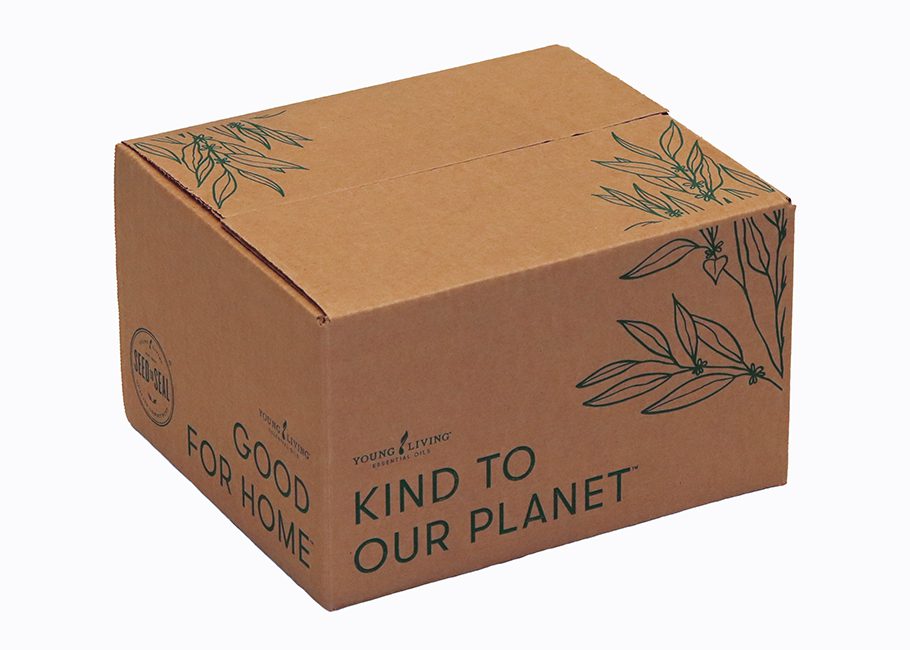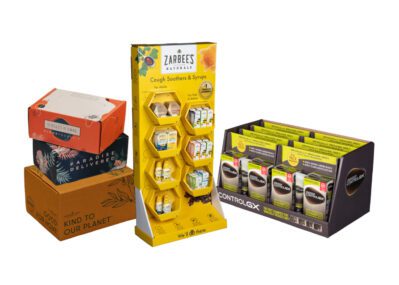
Young Living empowers wellness, purpose and abundance for communities around the world. From personal care to digestive wellness, they harness the power of nature’s living energy to enrich humanity through their manufacturing and distribution of essential oils. Young Living’s commitment to sustainability can be seen in all that they do. On its path to becoming a world leader in essential oils and wellness solutions, Young Living came up against challenges that arose from something most companies covet—growing demand.
Young Living’s internal operations had production primed for increased demand. So where in its manufacturing line did the issues surface? At the point where its products were being packaged for shipment to the homes of consumers.
If Young Living was to continue to grow successfully, it would need to find a new packaging supplier—one that could meet its unique packaging and production needs while aligning with its overall sustainability goals.
Sustainability and DTC Demand
For Young Living, finding a packaging supplier that checked all its packaging requirements was top of mind, but it was also of great importance to find an organization that supported its sustainability goals and initiatives. Young Living recognizes the importance of sustainability from its own standpoint but also from the standpoint of the consumer. And today’s consumers want to see sustainability throughout the various touchpoints of their purchasing journey.
For Young Living, consumer demand may be a factor in its drive toward sustainability, but, even more so, this mission is integral to its essence as an organization. Prasad Gankanda, Young Living’s Chief Operating Officer, puts it this way: “As the global leader in the essential oils space, we are committed to preserving the environment and making a positive impact in all that we do.” Young Living’s commitment to sustainability was clearly demonstrated throughout its product line, but the company could make even more progress by incorporating those same principles throughout its entire manufacturing chain by addressing its end-of-line packaging too.
Enter PCA—Solutions to Production Problems
In 2019 PCA and Young Living initiated their first contact. Through their ongoing conversations, Young Living learned more about PCA and its sustainability efforts and goals. Once it was established that PCA’s goals aligned well with Young Living’s, its leadership team was brought in to learn how PCA could support its operations. Young Living explained its production challenges, including unmet corrugated needs and challenges in box setup.
Together, PCA Area Sales Manager Cecil Cowdell and PCA’s quality and design teams began to review and analyze Young Living’s current corrugated materials, its production processes and its ongoing challenges.
PCA began the process by analyzing the corrugated being used. One of Young Living’s production problems was its current supplier’s corrugated board grade was outside the parameters of its box setup equipment, causing production interruptions and downtime. PCA identified and implemented an alternate high-performance board grade that would safeguard Young Living’s products and meet their production demands while running efficiently on its setup equipment. In doing so, Young Living was able to realize a reduction in weight of the material being used while still maintaining the performance of the boxes for shipping.
Once the proper corrugated grade was identified, PCA determined that Young Living could resize its boxes for greater efficiencies. By “rightsizing” packaging, it would be able to optimize raw materials while reducing redundancies in inventories. By customizing the corrugated boxes to specific product needs, Young Living was able to consolidate SKUs for improved inventory management, thereby increasing operational efficiencies and reducing costs.
“We were able to design new boxes that specifically addressed issues they were having with some of their box setup machines,” said Cowdell. “We also set up a vendor-managed inventory program to help them reduce inventory.”
A Sustainable Success Story
Since establishing this partnership, Young Living has certainly seen dividends in both the operational side of its business and in its ability to meet its sustainability goals. “PCA’s values align with our sustainability initiatives,” Gankanda said. “We’re excited that together we can amplify our shared commitment to the environment while providing the high-quality end product that our customers expect from us.”
While the Young Living team was impressed by PCA’s solutions to their pressing production and logistics problems, it was the complete and unique package offered by PCA that sealed the deal. Here are some of the main reasons that Young Living decided to partner with PCA:
- The collaborative process that PCA used to address Young Living’s unique packaging and production demands
- PCA’s financial flexibility and its track record of continuing to invest and grow to meet customers’ needs, which eliminated any concerns that Young Living had about production capacity and quality
- PCA’s national footprint of plants and design centers near Young Living’s distribution centers around the U.S.
- The opportunity to partner with an organization like PCA, who is just as committed to sustainability and to designing packaging that minimizes environmental impact
Looking at Young Living as a model, it becomes clear that sustainability and enhanced efficiency can go hand in hand moving forward.
Interesting in learning more? Fill out the form below, and we’ll have a local packaging expert reach out to you.


